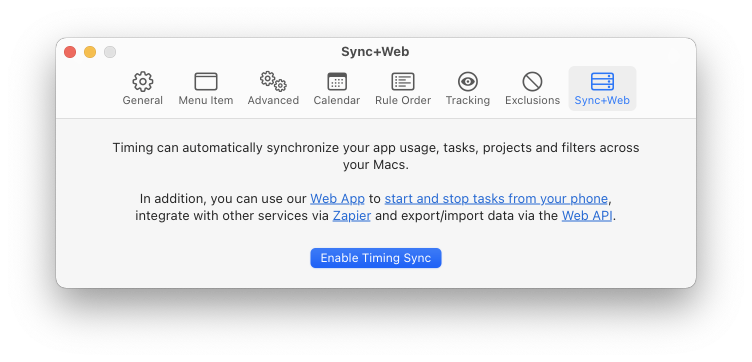Timing Sync
Timing Sync lets you automatically synchronize your Timing data across several Macs. Even if you only use one Mac, Timing Sync makes for a great off-site backup of your valuable time-tracking data!
In addition, a Timing Sync account is required to use Timing's AI features, the Timing web app (e.g. for tracking time on the go) as well as Timing for Teams.
Table of Contents
Setup
To get started, click this link on your Mac and allow it to open the Timing app, or navigate to the corresponding preference pane manually:

Once you click "Enable Timing Sync", you will be prompted to sign up for a new account or sign in with your existing credentials. If you'd like to reset your password, you can do so here.
After you have signed in, Timing will automatically start merging your local time-tracking data with the data
already stored in your sync account.
Once that has finished, you can repeat this process on your next Mac, until all your devices are set up.
Usage
Timing Sync does not need any maintenance or manual interaction; once set up, it will automatically ensure that your data is in sync across all your devices.
If you would like to use one of our additional features built on top of Timing Sync, please refer to the corresponding documentation pages:
Distinguishing Between Devices
On the timeline, you can tell which device a given activity was recorded on:

You can also give your devices custom names; to do so, simply click the device's name in the legend to the left of the timeline, then enter the desired name.
In addition, you can temporarily hide times from specific devices if you are not interested in them.
Importing Times from iPhone and iPad
Timing can also display the time you spent on your iPhone and iPad, but that feature is unrelated to our sync functionality. Instead, you'll need to set up our dedicated Screen Time integration in order to have Timing import your Screen Time data.
Account Security
You can secure your Timing Sync account with two-factor authentication (2FA). Activating 2FA will not log out any active sessions, but you will need to enter a code the next time you log in after activating 2FA. You can activate 2FA on the Timing web app.
Changing your email address
To change the email address associated with your Timing Sync account, please open your profile page in the Timing web app.